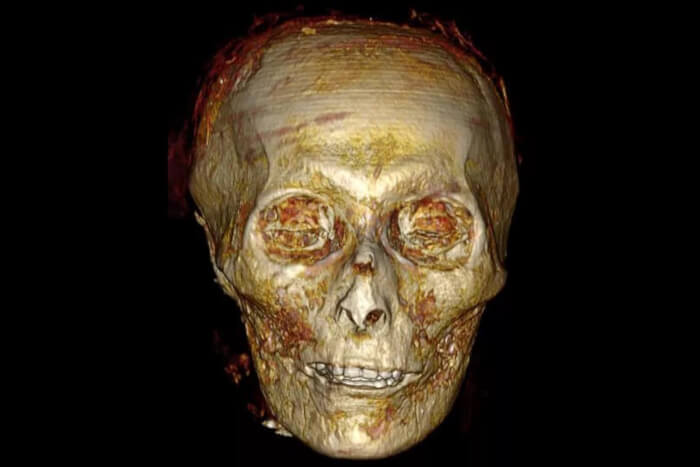Mummy Of Pharaoh Amenhotep I “Digitally Unwrapped”, Revealing Many Secrets
Egyptian researchers have exposed a 3,500-year-old regal mummy without peeling away a single layer of the mummified linen. Instead, King Amenhotep I’s embalmed remains and the thousand-year-old mysteries behind are revealed by X-ray technology and computerized tomography scanning.
The discovery was published in a research co-authored by Zahi Hawass, a prominent Egyptologist and Dr. Sahar Saleem a radiology professor at Cairo University’s department of medicine. Zahi said, “For the first time we can know information about the mummy without disturbing the mummy.”
The face of the prehistoric pharaoh could be observed through scanning technology, while his age, height and health status were also studied. Specifically, Amenhotep I had an oval face with a narrow chin, small nose and mildly protruding upper teeth.
Moreover, during the embalmment, the brain of the pharaoh wasn’t removed, which is totally different from that of other pharaohs of the modern kingdom, including Tutankhamun and Ramses II. 30 amulets and a belt with golden beads were also found in his burial.
Amenhotep I’s reign lasted for 21 years from 1525 to 1504 B.C. Scientists hasn’t been able to locate his crypt yet, but they had found his mummy reburied in Luxor in 1881. Normally, the CT technology is used in clinical contexts to scan living bodies, but Egyptian scientists were able to employ it to research mummies in a non-disruptive method.
“Like slices of toast, when put together, make a full loaf of bread,” Saleem said. “The technique enabled me to digitally remove the wrapping to visualize the amulets in between the layers, and to visualize the face of the mummy.”
Hawass said it’s not the first time a mummy has been scanned digitally, but it's the first comprehensive analysis of its kind. He hoped to use the same technology soon, "We are planning now to do the same type of a study to all the royal mummies."
The discovery was published in a research co-authored by Zahi Hawass, a prominent Egyptologist and Dr. Sahar Saleem a radiology professor at Cairo University’s department of medicine. Zahi said, “For the first time we can know information about the mummy without disturbing the mummy.”
The face of the prehistoric pharaoh could be observed through scanning technology, while his age, height and health status were also studied. Specifically, Amenhotep I had an oval face with a narrow chin, small nose and mildly protruding upper teeth.
 Source: Zahi Hawass
Source: Zahi Hawass
Moreover, during the embalmment, the brain of the pharaoh wasn’t removed, which is totally different from that of other pharaohs of the modern kingdom, including Tutankhamun and Ramses II. 30 amulets and a belt with golden beads were also found in his burial.
Amenhotep I’s reign lasted for 21 years from 1525 to 1504 B.C. Scientists hasn’t been able to locate his crypt yet, but they had found his mummy reburied in Luxor in 1881. Normally, the CT technology is used in clinical contexts to scan living bodies, but Egyptian scientists were able to employ it to research mummies in a non-disruptive method.
 Source: Zahi Hawass
Source: Zahi Hawass
“Like slices of toast, when put together, make a full loaf of bread,” Saleem said. “The technique enabled me to digitally remove the wrapping to visualize the amulets in between the layers, and to visualize the face of the mummy.”
Hawass said it’s not the first time a mummy has been scanned digitally, but it's the first comprehensive analysis of its kind. He hoped to use the same technology soon, "We are planning now to do the same type of a study to all the royal mummies."
Share this article
Advertisement